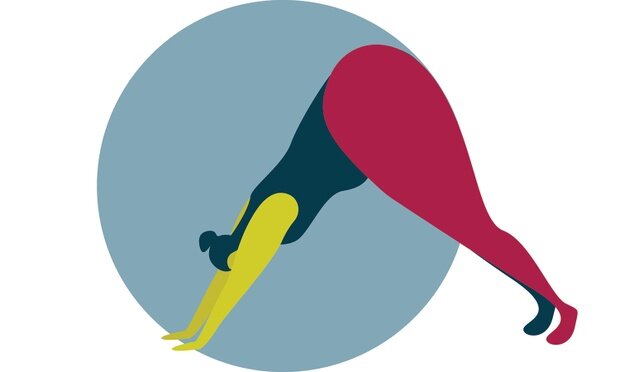I just wanted to talk a bit about downward-facing dog, because, well, it's a really hard yoga pose, and one of the most well-known out there. If I had a pound for every time someone told me they couldn't stay in it, or that they'd left a yoga class after the teacher harassed them for not being able to do so, I'd be... well, not rich, but I could buy a Nandos?
Anyway. Downward-facing dog, or adho mukhva svanasana. Let’s start off with something helpful: props.
Useful props
Some people like to have their hands on yoga bricks instead of the ground/mat - especially if you're coming into this from standing, this can be a great option
If you find the feet element challenging, a great option can be to get an angled wedge (cork or foam) and either use it as is or cut it up so that you can put your feet onto it
If you have a friendly friend close by, and a yoga strap, there are ways to get them to help you find that lift
Why is it so hard?
Well, first up, any posture that puts a lot of pressure through the wrists and hands, elbows and shoulders is tough. That's your whole body weight.
Timing
We’re often asked to go into this at the start of a practice, when our muscles aren't limber and loose, or the close of a practice, when, to be frank, we're often exhausted and just want to lie down. I've been in many classes where I've been expected to hold it for what feels like hours really early on: you aren't going to get any greater benefit just because you can stick with it.
I've always found that I have a greater rate of success with downward-facing dog when I'm warm, in the middle of my practice, and so on. One of my practices used to be ashtanga, and in ashtanga, you must hold about a million of them throughout. I started limbering and warming up before I went straight into the sun salutations that preface the standing and seated poses, and found that it really helped me. In the end, though, that caused a lot of drama for me, but that’s another story of another time.
Flexion
Another thing to consider might be the amount of flexion you have through the wrists and ankles. While some of us might experience lack of flexion due to a rheumatoid condition such as arthritis, it can also be that your body naturally doesn't have a great deal of it, and that's fine too. In this case, support yourself with things like blocks or cork wedges under the hands or feet, or, you could even transfer your practice to the wall, and avoid having to make it quite so intense in the first place.
One small part of it is also just consistency in practice. When your body is used to moving in a certain way, it eventually becomes muscle memory.
What else might be going on?
A cartoon of a female practitioner in downward-facing dog
Slippery hands
Bane. Of. My. Existence.
Chalk: you can buy a chalk ball pretty cheaply off somewhere like Amazon. Then you rub the chalk on your hands and, at least for a time, it should help with slippage
Is your mat serving you? For me, the only mat that I can use without my hands sliding in downward dog (and I’m not that sweaty!) is a Liforme. I’m rock solid once I’m there, and friends say the same.
Now, these are not pricey (£80 travel, £100 full-size), and don’t suit everyone because the travel version is thin, or some people don't actually want to not slide, but there is something for everyone. I know people who swear by Manduka Pro, Sweaty Betty mats or EkoJade.
Remember, you don’t necessarily need a mat. It’s a modern invention! Try going on the floor instead, and see if the carpet or wood floor works better for you. This is especially easy when at home… Just make sure you pad your knees!
Top tips
There are so many things in downward-facing dog, don't try and do everything at the same time! Progress is incremental.
Imagine you're two planks of wood propped against each other. Visualise a triangle in your mind as you do it. You are that triangle
Spread the palms - get as much purchase as possible, try not to lean into one side or the other
Notice if the knuckles are up high, if the fingertips won't come down to the earth - gain some awareness around how your hands work in pressure postures like this
Don't worry about planting the feet on the floor - heels high is just fine! It'll be your natural state: that's a healthy place to be
Find lift through the belly and the chest (you can do this by breathing into the lower back, engaging the abdominals)
Find space in the front and back of the chest: imagine you're broadening through both, the shoulders are further apart (a lot of yoga is about visualisations, rather than any big physical changes)
Imagine the hip bone connecting into the hip socket as you participate in it - this is another engagement too
Other pose options
Another option (although this can be harder!) is to have the forearms on the floor, either parallel or with the hands clasped. This is actually a different yoga pose, but it's another option which allows for more surface area for your body, and therefore less pressure in the wrists
Play with doing it against the wall and having your heels there
Finally, please please please do not ever feel like you need to stay in this pose. You can come in and out of it dynamically, you can substitute all fours, child's pose, or anything else that suits you, whether it's part of a flow of poses, or just being held by itself


